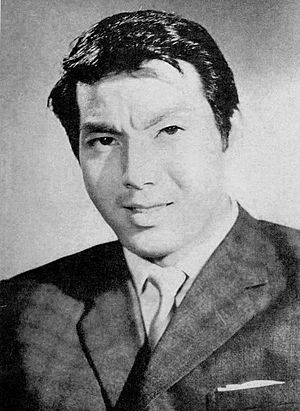Joe Shishido facts for kids
Quick facts for kids
Joe Shishido
|
|
|---|---|

Joe Shishido in 1961
|
|
| Born |
Jō Shishido
December 6, 1933 Kita, Osaka, Japan
|
| Died | January 18, 2020 (aged 86) |
| Occupation | Actor |
| Years active | 1955–2016 |
| Height | 1.74 m (5 ft 8+1⁄2 in) |
| Children | Kai Shishido |
Joe Shishido (宍戸 錠, Shishido Jō, December 6, 1933 – January 18, 2020) was a famous Japanese actor. He was known for his unique look and his exciting roles in action movies, especially as tough guys. He acted in about 300 films! Many people outside Japan remember him from the movie Branded to Kill (1967). In Japan, he had a cool nickname: Joe the Ace. He got this name from his popular role in the movie Quick Draw Joe (1961).
Contents
Growing Up and Starting Out
Joe Shishido was born in Osaka, Japan. He had two older brothers, a younger sister, and a younger brother named Eiji Go who also became an actor. Joe went to schools in Tokyo and Miyagi.
In 1952, he finished high school. Then, he joined a theater course at Nihon University. Two years later, he tried out for a contest held by the Nikkatsu Company. He was one of only 21 people chosen from 8,000 who applied! Joe left school and started working for Nikkatsu, getting small roles in movies.
Becoming a Star at Nikkatsu
In 1954, Joe Shishido signed a contract with Nikkatsu. The studio wanted him to change his name. This was because a famous samurai story had a bad guy named Shishido. But Joe said no! His first important role was in Policeman's Diary (1955). In this movie, he played a young police officer who challenged his chief to a kendo (bamboo sword fighting) match.
Joe wasn't happy with his roles in romantic movies. He also thought his face looked too plain. So, in 1957, he had surgery to make his cheekbones bigger. Some people said his new look was "ruggedly handsome." Others thought he looked a bit like a chipmunk!
After this change, he started getting bigger parts. He often played villains in action movies. He became very popular in the late 1950s and early 1960s. He starred with Akira Kobayashi in the "Birds of Passage" series. He also worked with Keiichirō Akagi in the Kenjū Buraichō series.
When Akagi sadly died in a go-karting accident, Joe Shishido became Nikkatsu's main action star. His first starring role was in Joe of Aces-Gambling for a Living (1961). This movie was a big hit! It led to two more movies right away: Joe of Aces-Body Guard and Joe of Aces-Give and Take'7. He became famous across Japan and kept the nickname "Joe the Ace" for life. This was thanks to his role in Quick Draw Joe (1961). In that movie, he played "the third-fastest draw in the world—0.65 seconds."
Even though he often played funny action roles, Joe Shishido also became known as a tough, lone hero. For example, in Seijun Suzuki's Youth of the Beast (1963), he played a former police officer. This character went undercover to join two rival yakuza gangs. Joe Shishido is best known outside Japan for his films with director Seijun Suzuki. These include Detective Bureau 2-3: Go to Hell, Bastards! (1963) and Gate of Flesh (1964).
His most famous movie around the world is Suzuki's Branded to Kill (1967). In this film, he played the third-best hitman in Japan. When it first came out, the movie wasn't very successful. This was partly because Nikkatsu studio didn't promote it well. They were having problems with director Suzuki, and he was eventually fired. Joe Shishido remembered watching the movie with friends and seeing almost no one else in the theater.
By the late 1960s, Nikkatsu's action movies became less popular. The studio made fewer films, which meant fewer jobs for Joe. He started taking roles with other companies and in television shows. These roles were often funny. He also starred in some Nikkatsu "new action" films. These included Yakuza Bird of Passage:Bad Guys' Work (1969) and Bloody Battle (1971).
Later Career and Legacy
Joe Shishido continued to work in television. He also appeared in movies for other studios. One notable film was the fifth part of Toei's popular yakuza series, Battles Without Honor and Humanity: Final Episode (1974). Around this time, yakuza films started to lose their popularity. So, Joe stopped playing those kinds of roles.
For the next 20 years, he mostly worked in television. He made occasional movie appearances too. These included Exchange Students (1982) and Bound for the Fields, the Mountains, and the Seacoast (1986). His tough-guy image returned in the Mike Hama: Private Eye trilogy by Kaizo Hayashi. This series included The Most Terrible Time in My Life (1994), The Stairway to the Distant Past (1995), and The Trap (1996).
Sadly, on February 4, 2013, Joe Shishido's house was destroyed in a fire. Luckily, he was not home at the time, and no one was hurt.
Joe Shishido passed away on January 18, 2020. He was found at his home on January 21, 2020. He was survived by his three children.
Selected Filmography
- 1955 Keisatsu Nikki
- 1958 Rusty Knife
- 1961 Quick Draw Joe
- 1963 Youth of the Beast
- 1964 Gate of Flesh
- 1967 Branded to Kill
- 1974 Battles Without Honor and Humanity: Final Episode
- 1982 Tenkōsei
- 1994 The Most Terrible Time in My Life
- 1996 The Trap
Selected Television Roles
- 1973 Kunitori Monogatari – Shibata Katsuie
- 1978 Star Wolf – Captain Joe
- 1988 Takeda Shingen – Hara Toratane
- 2000 Aoi Tokugawa Sandai – Honda Tadakatsu
- 2009 Tenchijin – Naoe Kagetsuna

